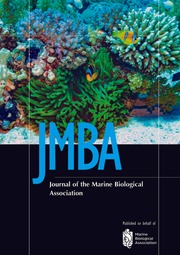Crossref Citations
This article has been cited by the following publications. This list is generated based on data provided by
Crossref.
Barahona, Mario
and
Navarrete, Sergio A.
2010.
Movement patterns of the seastar Heliaster helianthus in central Chile: relationship with environmental conditions and prey availability.
Marine Biology,
Vol. 157,
Issue. 3,
p.
647.
Robinson, L. M.
Elith, J.
Hobday, A. J.
Pearson, R. G.
Kendall, B. E.
Possingham, H. P.
and
Richardson, A. J.
2011.
Pushing the limits in marine species distribution modelling: lessons from the land present challenges and opportunities.
Global Ecology and Biogeography,
Vol. 20,
Issue. 6,
p.
789.
Melnick, Daniel
Cisternas, Marco
Moreno, Marcos
and
Norambuena, Ricardo
2012.
Estimating coseismic coastal uplift with an intertidal mussel: calibration for the 2010 Maule Chile earthquake (Mw = 8.8).
Quaternary Science Reviews,
Vol. 42,
Issue. ,
p.
29.
Rogers, Tanya L.
and
Elliott, Joel K.
2013.
Differences in relative abundance and size structure of the sea stars Pisaster ochraceus and Evasterias troschelii among habitat types in Puget Sound, Washington, USA.
Marine Biology,
Vol. 160,
Issue. 4,
p.
853.
Baeta, Marc
and
Ramón, Montserrat
2013.
Feeding ecology of three species of Astropecten (Asteroidea) coexisting on shallow sandy bottoms of the northwestern Mediterranean Sea.
Marine Biology,
Vol. 160,
Issue. 11,
p.
2781.
Liversage, Kiran
2015.
Habitat associations of a rare South Australian sea star (Parvulastra parvivipara) and a co-occurring chiton (Ischnochiton variegatus): implications for conservation.
Pacific Conservation Biology,
Vol. 21,
Issue. 3,
p.
234.
Baeta, Marc
Galimany, Eve
and
Ramón, Montserrat
2016.
Growth and reproductive biology of the sea star Astropecten aranciacus (Echinodermata, Asteroidea) on the continental shelf of the Catalan Sea (northwestern Mediterranean).
Helgoland Marine Research,
Vol. 70,
Issue. 1,
Hemery, Lenaïg G.
Marion, Scott R.
Romsos, Chris G.
Kurapov, Alexander L.
Henkel, Sarah K.
and
Thuiller, Wilfried
2016.
Ecological niche and species distribution modelling of sea stars along the Pacific Northwest continental shelf.
Diversity and Distributions,
Vol. 22,
Issue. 12,
p.
1314.
Escobar, Joan B.
Knight, Christopher
and
Navarrete, Sergio A.
2018.
Predation on competing mussel species: Patterns of prey consumption and its potential role in species coexistence.
Journal of Experimental Marine Biology and Ecology,
Vol. 504,
Issue. ,
p.
38.
Rogers, TL
Schultz, HK
and
Elliott, JK
2018.
Size-dependent interference competition between two sea star species demographically affected by wasting disease.
Marine Ecology Progress Series,
Vol. 589,
Issue. ,
p.
167.
Ohtsuchi, Naoya
Kawamura, Tomohiko
Hayakawa, Jun
Kurogi, Hiroaki
and
Watanabe, Yoshiro
2018.
Ontogenetic habitat shift in Pugettia quadridens on the coast of Sagami Bay, Japan.
Fisheries Science,
Vol. 84,
Issue. 2,
p.
211.
Wilmes, Jennifer C.
Hoey, Andrew S.
and
Pratchett, Morgan S.
2020.
Contrasting size and fate of juvenile crown-of-thorns starfish linked to ontogenetic diet shifts.
Proceedings of the Royal Society B: Biological Sciences,
Vol. 287,
Issue. 1931,
p.
20201052.
Garrido, Ignacio
Pardo, Luis Miguel
Johnson, Ladd E.
and
Schories, Dirk
2021.
Selective Feeding by a Predatory Sea Star Across a Depth Gradient in Northern Patagonia, Chile.
Frontiers in Marine Science,
Vol. 8,
Issue. ,
Le Bourg, B
Kuklinski, P
Balazy, P
Lepoint, G
and
Michel, LN
2021.
Interactive effects of body size and environmental gradient on the trophic ecology of sea stars in an Antarctic fjord.
Marine Ecology Progress Series,
Vol. 674,
Issue. ,
p.
189.
Manríquez, Patricio H.
Jara, María Elisa
González, Claudio P.
Seguel, Mylene
Quijón, Pedro A.
Widdicombe, Stephen
Pulgar, José M.
Quintanilla-Ahumada, Diego
Anguita, Cristobal
and
Duarte, Cristian
2021.
Effects of artificial light at night and predator cues on foraging and predator avoidance in the keystone inshore mollusc Concholepas concholepas.
Environmental Pollution,
Vol. 280,
Issue. ,
p.
116895.
Maganhe, Bruna L.
Andrade, Laura S.
Camilo, Laura de O.
Neto, Hugo G.
and
Sanches, Eduardo G.
2023.
Food‐related substrate preference in juveniles seastar Echinaster (Othilia) brasiliensis (Müller & Troschel,1842) in captivity.
Zoo Biology,
Vol. 42,
Issue. 5,
p.
675.




